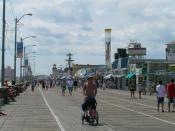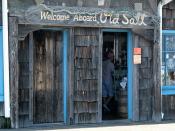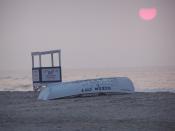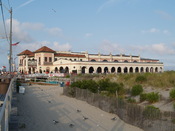The Wreck of the Sindia My project deals specifically with the shipwreck of a sailing vessel named The Sindia. The Sindia was a four masted cargo carrier registered out of Liverpool, England. Her main job was to carry freight from port to port. The majority of cargo she transported was oil, silk, and novelties and trinkets. ( Lee, 1-2) Her last voyage was to have taken her from New York to Shanghai, China. She was to travel from Shanghai to Kobe, Japan and then back to New York. She had accomplished most of this voyage and was on her way home along the eastern seaboard of the United States when she ran into a severe northeastern storm. This was the storm that was to claim the Sindia forever. (Lee, 1-2) All events took place on December 15, 1901 off the coast of Ocean City, New Jersey. When the Sindia was sailing up the coast she found herself caught at sea in the midst of the storm.
She looked to seek refuge in the waters closer to shore. As she moved closer to shore the captain did not realize the dangers of the waters surrounding Ocean City. The boat sailed too close to the shore and became grounded on a sandbar. The weight of the ship held it tight in the sticky ocean sand. The ship struck the sandbar head on and the whipping winds caused the boat to turn broadside and burrow deeper into the sand. Once the ship lay on the beach, the captain ordered distress signals to be sent immediately. At 2:30 in the morning the signals were seen by the Ocean City and Middle life saving stations, who responded immediately to the 16th street beach. These distress signals brought curious onlookers from the town out to the beach to see what the commotion was about. At daybreak, the rescuers using a surf boat, were finally able to make it out to the doomed ship. When the first lifesaving personnel arrived on the ship the captain would not let any of the crew leave the ship. He finally relented and agreed to let 26 men go ashore. (Lamphear, 8-9) After the men were off the ship and safe on shore, there still was the problem of the cargo on the grounded Sindia. How were they going to get the cargo off of the stranded ship? A consensus of those involved, including the captain, crew, rescuers and townspeople seemed to come up with the same idea. A wrecking company would be hired to salvage all it could from the ship. Due to the fear of another storm the company was hired to start the salvage work immediately. Another reason to begin the work was to salvage the items before looters ransacked the ship.
As the company continued its efforts the salvaged material was first sold to the New York underwriters and put up for auction. The auction did not work out the way the underwriters had hoped. ( Seibold, 10-15) Later, the ship, including cargo, was sold to the Sindia Company for $ 5,500. The estimated value of the cargo alone was $1,200,000. While most of the items salvaged were sold on the Ocean City Boardwalk, a large amount of her contents still lay in the hull today. ( Seibold, 10-15) Once the wrecking crew abandoned its operations on the vessel and the work was done, it became a popular play place for children and families visiting the beach. My Grandmother can recall playing in and around the ship as a child. In the pictures taken of the deteriorating ship you can see children playing and sitting all around the ship. It became so popular that the city built a boardwalk out to the ship. They charged people to come out there and they turned it into a major tourist attraction of Ocean City. Many of the pictures that you see of the sunken ship are of its masts and parts laid strewn on the beach. My Grandmother and Aunt can remember there times spent playing on the ship. They both recall playing on the metal parts that still lay above the surface. These parts remained longer then the ship because of the material of which they were made. My Grandmother told me that as time passed you had to be more careful when going out to play on the ship because the waves had formed gullies around the hull of the ship. These gullies were deeper and had a stronger current then the surrounding ocean. She also recalled how the ship began to disappear over the years. You can see this transformation in the pictures. First, the wood started to deteriorate and separate from the heavier metal objects and then it broke down completely. As the years passed the ship sank lower into the sand and soon all that could be seen of the ship was its huge masts. They remained upright until a storm tore them down too. Once there was no more wood above the surface all that remained were the heavy metals pieces that lay strewn on the beach. These objects were soon removed and taken to the historical museum where they remain to this day.
There have been a few attempts to raise the sunken ship over the years but none of them have been successful. The project is so large that it will take a mass effort, both financially and in man-hours, to raise the ship. People believe that if they can raise the ship from its watery grave that they will be able to access the treasure still believed to be inside the hull. ( Cain, 60-69) It has been 100 years since the Sindia went down off of the Ocean City coast and it still remains a talked about topic in Ocean City today. There are few people still alive that were present the night it happened but there are many people still alive that have seen the wreck over the years.
The Ocean City Historical Museum is dedicated to the shipwreck and they have many of the artifacts salvaged from the ship on display. If you think that Ocean City is a boring place to live you might just have to dig a little deeper t o find some of the great mysteries and treasures that this island hides under the sand. The wreck of the Sindia is just one of them and there are many more shipwrecks that lay off the Ocean City and New Jersey coastline.




